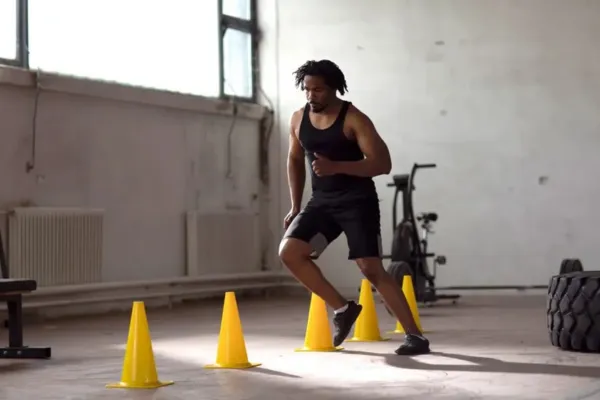
Read Our Blogs

Volleyball and Agility: Quick Feet, Quick Reactions
Volleyball is a sport of rapid movements, split-second decisions, and explosive reactions. Agility, the ability to change direction quickly and efficiently while maintaining control, is paramount to success on the volleyball court. It's the difference between diving for that impossible dig, reaching for that game-winning block, and outmaneuvering your opponent to secure the point.
Agility is more than just speed; it's a combination of physical and mental attributes that allow you to move with grace, precision, and explosiveness. It's about mastering your body's movements, anticipating your opponent's actions, and reacting with lightning-fast reflexes.
Why Agility Matters: The Cornerstone of Volleyball Success
Agility is not just a desirable trait for volleyball players; it's a fundamental skill that underpins every aspect of the game. Here's why:
Faster Reactions: Anticipate and Respond
Volleyball is a game of anticipation and reaction. The ability to read the play, predict the trajectory of the ball, and react quickly is crucial for success. Agility training sharpens your reflexes, allowing you to respond instinctively to serves, spikes, and digs.
Whether it's diving to save a hard-driven spike or adjusting your position to receive a tricky serve, agility allows you to react with speed and precision, giving you a competitive edge.
Improved Court Coverage: Dominate the Court
Agile players can cover more ground, making them more effective defenders and attackers. They can quickly transition from offense to defense, close gaps in the court, and reach balls that would otherwise be out of reach.
This enhanced court coverage allows you to be a more versatile player, contributing to both offensive and defensive plays. You can seamlessly transition from a powerful spike to a diving dig, keeping your opponents on their toes and maximizing your team's potential.
Enhanced Balance and Control: Master Your Movements
Agility is not just about speed; it's about control. Agile players possess exceptional balance and coordination, allowing them to execute movements with precision and fluidity.
Agility drills improve your balance and coordination by challenging your proprioception – your body's awareness of its position in space. This enhanced body control allows you to make quick adjustments, maintain your balance during dynamic movements, and execute skills with greater accuracy.
Reduced Injury Risk: Build a Resilient Body
Agility training strengthens the muscles and joints involved in quick movements, reducing the risk of sprains, strains, and other injuries common in volleyball.
By improving your flexibility, balance, and coordination, agility training helps you move more efficiently, reducing the stress on your joints and muscles. This can help prevent injuries and ensure that you can continue to play the sport you love without limitations.
Agility Drills: Sharpening Your Skills
Agility training involves a variety of drills and exercises designed to challenge your reflexes, coordination, and speed. Here are some effective agility drills for volleyball players:
Ladder Drills: Footwork Finesse
Ladder drills are a staple of agility training, improving foot speed, coordination, and agility. Various patterns can be performed, focusing on quick steps, precise foot placement, and maintaining a low center of gravity.
Some popular ladder drills include the Ickey Shuffle, the Lateral Shuffle, and the In-Out Drill. These drills challenge your footwork, coordination, and rhythm, improving your ability to move quickly and efficiently.
Cone Drills: Mastering Change of Direction
Cone drills enhance your ability to change direction quickly and efficiently. Set up cones in various patterns and practice shuffling, sprinting, and backpedaling around them.
Cone drills can be tailored to simulate game-like situations, such as changing direction to chase down a dig or sprinting to reach a block. This helps you develop the agility and reaction time needed to excel in real-game scenarios.
Shuttle Runs: Speed and Endurance
Shuttle runs improve speed and endurance, essential for volleyball players who need to cover the court quickly and repeatedly throughout a match.
Sprint between two points, touching the ground at each end. Vary the distance and number of repetitions to challenge your speed and endurance.
Lateral Shuffles: Side-to-Side Mastery
Lateral shuffles are crucial for volleyball players, as they mimic the side-to-side movements required for defensive positioning and court coverage.
Practice shuffling side-to-side, maintaining a low center of gravity and quick footwork. Focus on staying low to the ground, keeping your core engaged, and moving with explosiveness.
Jump Rope: Coordination and Rhythm
Jumping rope is a simple yet effective way to improve foot speed, coordination, and cardiovascular fitness. It also helps develop rhythm and timing, which are crucial for volleyball movements.
Vary your jump rope routine by incorporating different footwork patterns, such as single-leg jumps, double-leg jumps, and criss-cross jumps.
Integrating Agility Training: A Holistic Approach
Agility training should be an integral part of your overall volleyball training program. Here are some tips for incorporating agility drills effectively:
Warm-up: Always warm up before agility training to prepare your muscles and joints for the demands of the exercises.
Proper Form: Focus on proper form and technique to maximize the benefits and prevent injuries.
Progression: Start with simpler drills and gradually progress to more complex ones as your agility improves.
Variety: Incorporate a variety of drills to challenge different aspects of agility, such as foot speed, change of direction, and reaction time.
Consistency: Make agility training a regular part of your routine to see consistent improvement.
Listen to Your Body: Pay attention to your body and avoid overtraining. If you're feeling pain or fatigue, take a break or modify the exercises.
Agility: A Lifelong Pursuit
Agility is not just for athletes; it's a valuable skill for everyone, regardless of age or fitness level. Improving your agility can enhance your overall fitness, reduce your risk of falls and injuries, and improve your performance in everyday activities.
Here are some additional tips for incorporating agility training into your lifestyle:
Incorporate agility drills into your workouts: Add agility drills to your regular fitness routine, whether you're working out at home, at the gym, or outdoors.
Play games that require agility: Engage in activities that challenge your agility, such as tag, ultimate frisbee, or dance classes.
Make it fun: Find ways to make agility training enjoyable, such as incorporating music or playing games with friends.
Challenge yourself: Gradually increase the difficulty of your agility drills as your fitness improves.
By incorporating agility training into your volleyball regimen and your overall lifestyle, you'll develop the quick feet, sharp reflexes, and exceptional balance needed to excel on the court and in life. Agility is not just about moving fast; it's about moving with purpose, control, and grace.
Reserve your Volley Pro now and become an agility master!

Reliable, professional pressure washing services for pristine results.
Copyright Volley Pro 2025. All rights reserved
